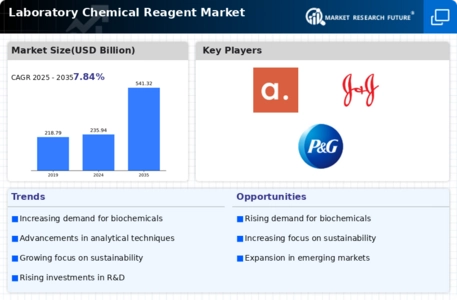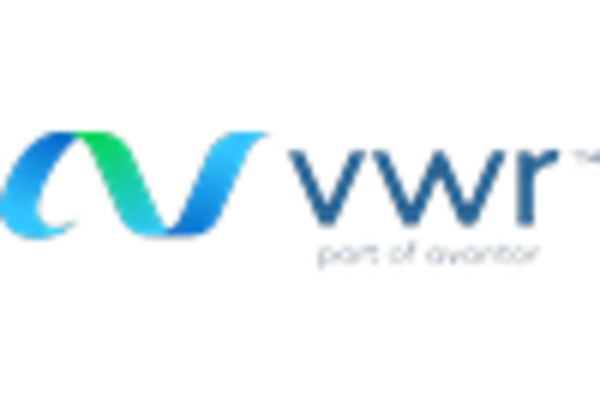Expansion of the Chemical Industry
The Laboratory Chemical Reagent Market is benefiting from the overall expansion of the chemical industry. As various sectors, including pharmaceuticals, agriculture, and food processing, grow, the need for laboratory reagents intensifies. In 2025, the chemical industry is projected to grow at a compound annual growth rate of 4%, which will likely drive the demand for laboratory chemicals. This growth is attributed to the increasing complexity of chemical processes and the need for precise analytical tools. Consequently, reagent manufacturers are expected to enhance their product offerings to meet the diverse needs of these expanding sectors. The symbiotic relationship between the chemical industry and the laboratory reagent market suggests a promising outlook for future growth.
Increasing Environmental Regulations
The Laboratory Chemical Reagent Market is influenced by the tightening of environmental regulations aimed at promoting sustainability. Governments are implementing stricter guidelines regarding the use and disposal of chemical reagents, compelling manufacturers to adapt their practices. In 2025, it is expected that compliance costs will rise by approximately 10%, impacting pricing strategies within the market. This regulatory landscape encourages the development of eco-friendly reagents, which are gaining traction among consumers. As laboratories prioritize sustainability, the demand for green reagents is likely to increase, prompting manufacturers to innovate and reformulate their product lines. The intersection of regulation and market demand could redefine the laboratory chemical reagent industry.
Rising Demand for Biopharmaceuticals
The Laboratory Chemical Reagent Market is experiencing a notable surge in demand due to the increasing focus on biopharmaceuticals. As the healthcare sector evolves, the need for high-quality reagents for drug development and testing becomes paramount. In 2025, the biopharmaceutical market is projected to reach approximately 500 billion USD, which directly influences the laboratory chemical reagent market. This growth is driven by advancements in biotechnology and the rising prevalence of chronic diseases, necessitating the use of sophisticated reagents for research and development. Consequently, manufacturers are likely to invest in innovative reagent formulations to cater to this expanding market, thereby enhancing their competitive edge.
Growth in Academic and Research Institutions
The Laboratory Chemical Reagent Market is significantly bolstered by the expansion of academic and research institutions. As educational and research facilities proliferate, the demand for laboratory reagents escalates. In 2025, it is estimated that the number of research institutions will increase by 15%, leading to a corresponding rise in reagent consumption. This trend is particularly evident in fields such as chemistry, biology, and environmental science, where reagents are essential for experiments and analyses. Furthermore, government funding for research initiatives is likely to enhance the procurement of laboratory chemicals, thereby driving market growth. The interplay between educational advancements and reagent demand suggests a robust future for the laboratory chemical reagent market.
Technological Innovations in Reagent Production
The Laboratory Chemical Reagent Market is poised for transformation due to ongoing technological innovations in reagent production. Automation and advanced manufacturing techniques are streamlining the production processes, resulting in higher efficiency and reduced costs. In 2025, it is anticipated that the adoption of automated systems will increase by 20% among reagent manufacturers. This shift not only enhances the quality and consistency of reagents but also allows for the rapid development of new products tailored to specific research needs. As laboratories seek to optimize their operations, the integration of technology in reagent production is likely to play a crucial role in shaping market dynamics, fostering a competitive landscape.


















Leave a Comment